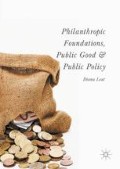Abstract
Foundations face a cluster of charges to do with their wealth and income. One charge concerns the source of the wealth with which the foundation was initially created—how the money was made and what harm, if any, was done in the process? A related but different charge concerns the effects of foundation formation on the tax base; do foundations erode the tax base in such a way as to neutralise any good they may do? Yet another charge is that the bulk of foundation money is not applied to public benefit and, worse, actually contributes to the problems foundations claim to want to solve.
Access this chapter
Tax calculation will be finalised at checkout
Purchases are for personal use only
References
Andrews, J., A. Briggs, R. Porter, P. Tucker, and K. Waddington. 1970. The history of Bethlem. London: Routledge.
Bakija, J. 2013. Tax policy and philanthropy: A primer on the empirical evidence for the United States and its implications. Social Research 80(2): 557–584.
Brealey, P. 2013. The charitable corporation for the relief of industrious poor: Philanthropy, profit and sleaze in London 1707–1733. History 98(333): 708–729.
Burkeman, S. 1999. An unsatisfactory company….? The 1999 Allen Lane Foundation lecture.
Center for Effective Philanthropy. 2015. Investing and social impact: Practices of private foundations. Washington, DC: Center for Effective Philanthropy.
Clark, C., J. Emerson, and B. Thornley. 2014. Collaborative capitalism and the rise of impact investing. London: John Wiley and Sons.
Dees, J.G. 2008. Philanthropy and enterprise: Harnessing the power of business and entrepreneurship for social change. North Carolina: Duke University.
Dorsey, E., and R. Mott. 2014. Why foundations should divest-invest. Alliance 19(1): 16.
Emerson, J. 2014. Horse manure and grantmaking. Foundation News and Commentary. May/June, 43(3). http://www.foundationnews.org/CME/article.cfm?ID=1950
Godeke, S., and D. Baker. 2008. Philanthropy’s new passing gear mission related investing: A policy and implementation guide for trustees. New York: Rockefeller Philanthropy Advisors.
Hall, P.D. 2006. A historical overview of philanthropy, voluntary associations and nonprofit organisations in the United States 1600–2000. In The nonprofit sector: A research handbook, 2nd ed, ed. W.W. Powell and R. Steinberg, 32–60. Boston: Yale University Press.
Harsanyi, D. 2011. What occupy Wall Street really wants. New York Post, October 6. http://nypost.com/2011/10/06/what-occupy.
John, R. 2006. Venture philanthropy: The evolution of high engagement philanthropy in Europe. Oxford: Skoll Centre for Social Entrepreneurship.
Liffman, M. 2004. Myer family philanthropy. Carlton: Melbourne University Publishing.
Maurer, B. 2008. Re-regulating offshore finance? Geography Compass 2/1: 155–175.
Mavity, J.H., and P. Ylvisaker. 1977. Private philanthropy and public affairs. In The commission on private philanthropy and public needs, research papers part 1, vol. 2, 795–836. Washington, DC: Department of Treasury.
Naughton, J. 2012. New-tech Moguls: The modern robber barons? The Guardian, July 1.
Nickel, P.M., and A.M. Eikenberry. 2009. A critique of the discourse of marketised philanthropy. American Behavioral Scientist 52(7): 974–989.
Piller, C., E. Sanders, and R. Dixon. 2007. Dark cloud over good works of the Gates Foundation. Los Angeles Times 7.
Reich, R. 2005. A failure of philanthropy. Stanford Social Innovation Review (Winter): 26–30.
Reich, R. 2013. Philanthropy and caring for the needs of strangers. Social Research 80(2): 517–538.
Schwartz, J. 2014. Rockefellers, heirs to an oil fortune will divest charity of fossil fuels. The New York Times, September 21.
Schweitzer, P. 2015. Clinton cash: The untold story of how and why foreign governments and businesses helped make Bill and Hillary rich. New York: Harper Collins.
Sutton, F.X. 1987. The Ford Foundation: The early years. Daedulus 116(1), Philanthropy, Patronage, Politics. pp. 41–91.
Wagner, G. 1987. The chocolate conscience. London: Chatto and Windus.
Watkiss, D. 2008. Robert Bosch Stiftung industrial giant funding good works. In Philanthropy in Europe: A rich past and a promising future, ed. N. MacDonald and L.T. de Borms, 37–52. London: Alliance Publishing Trust.
Author information
Authors and Affiliations
Copyright information
© 2016 The Editor(s) (if applicable) and The Author(s)
About this chapter
Cite this chapter
Leat, D. (2016). Sources of Wealth and Income. In: Philanthropic Foundations, Public Good and Public Policy. Palgrave Macmillan, London. https://doi.org/10.1057/978-1-137-48289-1_6
Download citation
DOI: https://doi.org/10.1057/978-1-137-48289-1_6
Published:
Publisher Name: Palgrave Macmillan, London
Print ISBN: 978-1-137-48288-4
Online ISBN: 978-1-137-48289-1
eBook Packages: Political Science and International StudiesPolitical Science and International Studies (R0)

